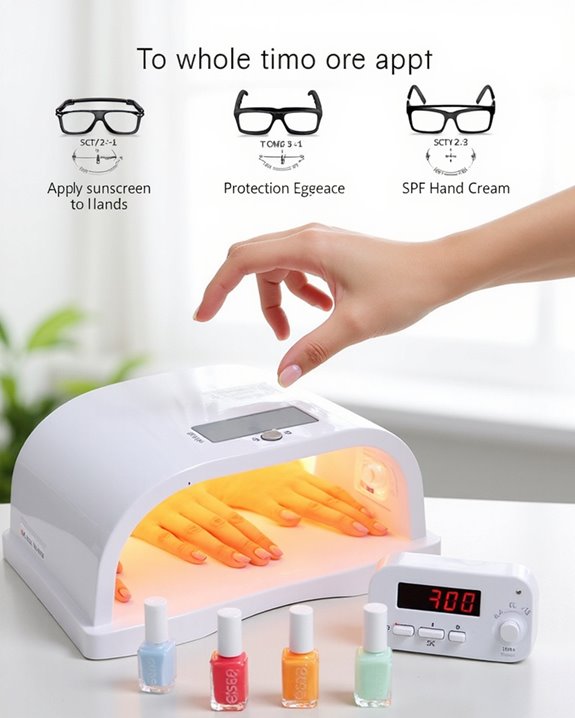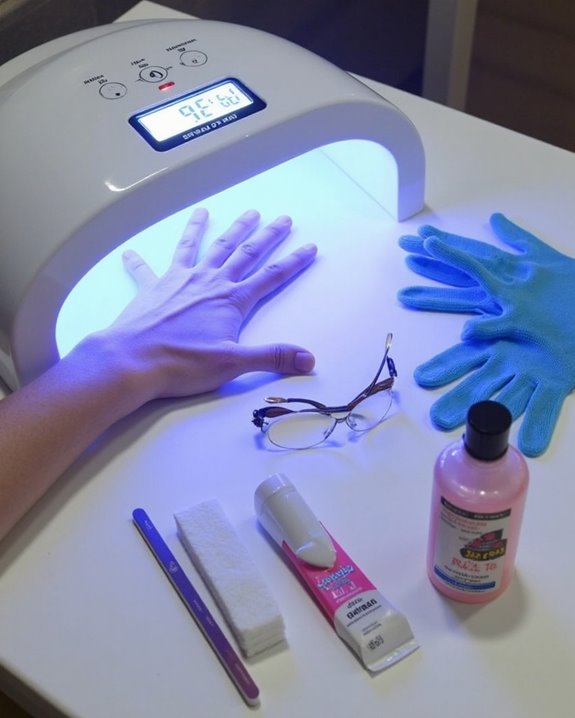LED nail lamps offer five significant safety advantages over traditional UV lamps. They emit targeted wavelengths (365-405nm) that efficiently activate gel polish with less radiation, cure in 30-60 seconds (half the time of UV lamps), consume less energy while lasting 50,000 hours (versus 4,000 for UV bulbs), maintain consistent performance throughout their lifespan, and produce lower overall radiation output. These improvements minimize potential skin damage risks while delivering effective results. The technical differences between these technologies reveal why salon professionals increasingly recommend LED options.
Key Takeaways
- LED nail lamps emit a narrower wavelength spectrum (365-405 nanometers) targeting only necessary photo-initiators in gel polish.
- Faster curing times of 30-60 seconds with LED technology reduce overall UV radiation exposure compared to 90-120 seconds with UV lamps.
- LED bulbs last approximately 50,000 hours versus 4,000 hours for UV bulbs, maintaining consistent performance throughout their lifespan.
- LED technology delivers lower overall radiation output while still effectively curing gel polish formulations.
- Energy-efficient LED design requires less power consumption while providing more focused curing capability than traditional UV lamps.
LED Lamps Deliver More Targeted Wavelengths of Light
When comparing nail lamp technologies, LED systems clearly deliver more targeted wavelengths of light that make them safer alternatives to traditional UV lamps. I’ve found that LED lamps emit a narrower spectrum, typically in the 365-405 nanometer range, which precisely activates the photo-initiators in gel polish without broadcasting unnecessary UV radiation. This targeted light approach means your skin receives less overall UV exposure during the curing process.
Unlike conventional UV lamps that scatter broader wavelengths, LED technology concentrates light energy exactly where it’s needed, reducing potential skin damage while still effectively curing your manicure. The precision of LED wavelengths also explains why they cure gel polish in just 30-60 seconds, compared to the longer exposure times required by UV lamps. This efficiency isn’t just convenient—it’s a significant safety advantage, limiting cumulative UV radiation exposure with each salon visit.
Shorter Curing Times Mean Less UV Exposure
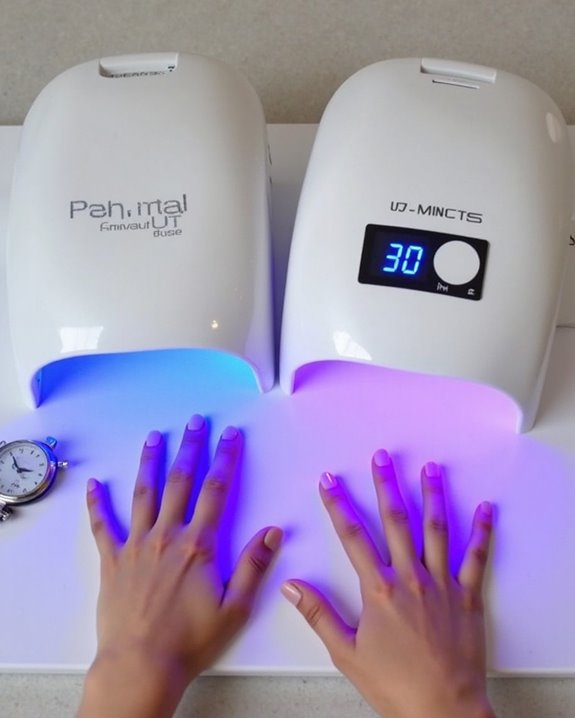
Because LED lamps complete the curing process in just 30-60 seconds, they greatly reduce the total UV exposure your skin receives during a manicure session. This is substantially faster than UV nail lamps, which typically require 90-120 seconds to cure gel polish, effectively doubling your radiation exposure during each gel manicure.
I’ve found that this time difference matters tremendously for your skin health. When comparing UV and LED lamps, the shorter curing time of LED technology means your hands experience only half the UV exposure of traditional methods. This reduced duration is comparable to brief everyday sun exposure rather than the extended sessions under UV nail lamps. By curing polish faster, LED nail lamps minimize the cumulative radiation dose your skin absorbs over multiple manicure appointments, making them a particularly safer option.
LED Technology Provides Better Energy Efficiency
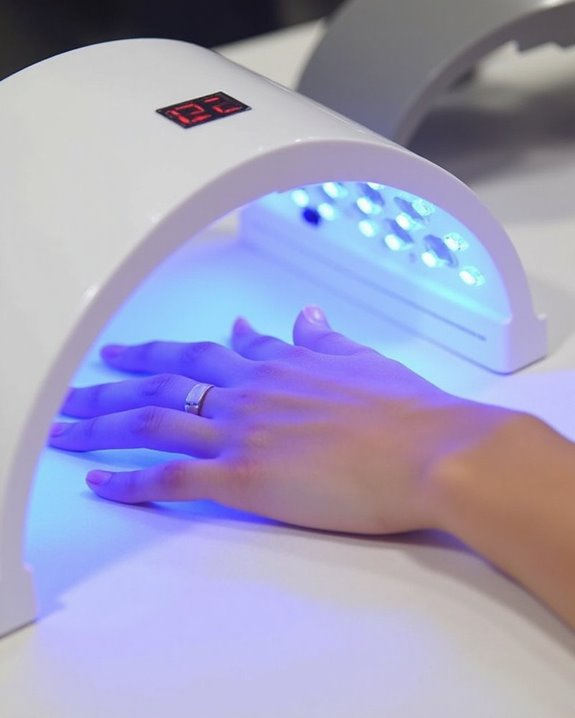
Beyond safety benefits, LED nail lamps offer impressive energy efficiency advantages compared to their UV counterparts. When using LED technology to cure polish, I’m always impressed by how LED lamps emit targeted wavelengths that require substantially less energy compared to UV lamps, which draw more power for broader spectrum emission. LED bulbs last approximately 50,000 hours, while traditional UV bulbs typically need replacement after just 4,000 hours, reducing waste from frequent replacements. Additionally, wattage and bulb quality play crucial roles in ensuring optimal energy use and curing performance. The energy-efficient design of LED light systems allows for faster curing times—typically 30-60 seconds per layer—minimizing total energy consumption during each manicure session. For salon owners and home users alike, this efficiency translates to lower electricity costs over time. The combination of bulbs that last longer and reduced power requirements makes UV and LED nail technology comparison heavily favor LED options for environmental and economic reasons.
Longer Bulb Lifespan Ensures Consistent Performance
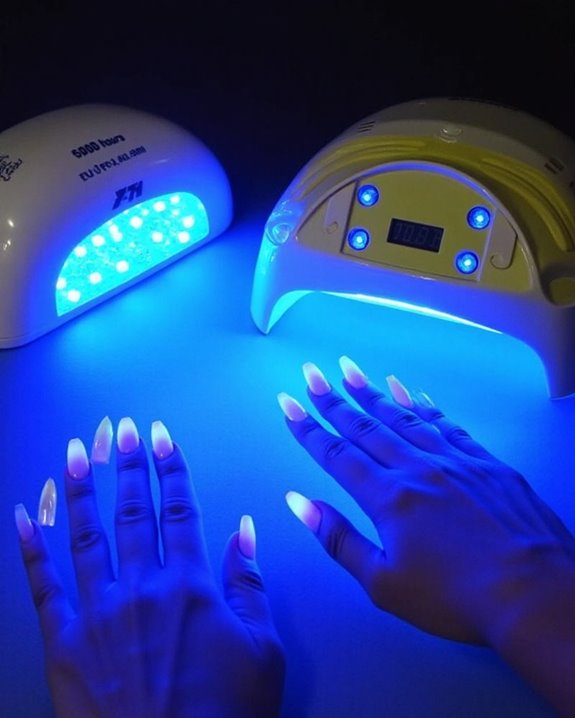
The remarkable longevity of LED bulbs represents one of their most significant advantages over traditional UV counterparts in nail lamp technology. When comparing UV vs LED curing lamps, the difference between the two is striking—LED bulbs last up to 50,000 hours, while standard UV light bulbs need replacement after just 4,000 hours. This extended lifespan matters tremendously for the type of lamp you select for nail treatments.
While both types of lamps contain UV and are used to cure gel products, the amount of UV exposure can fluctuate as bulbs degrade. With traditional lamps requiring replacement every six months, performance becomes inconsistent. I’ve found that LED curing lamps maintain steady radiation levels throughout their lifespan, eliminating the unpredictable exposure patterns that can occur with aging UV bulbs.
The Science Behind LED’s Reduced Radiation Output
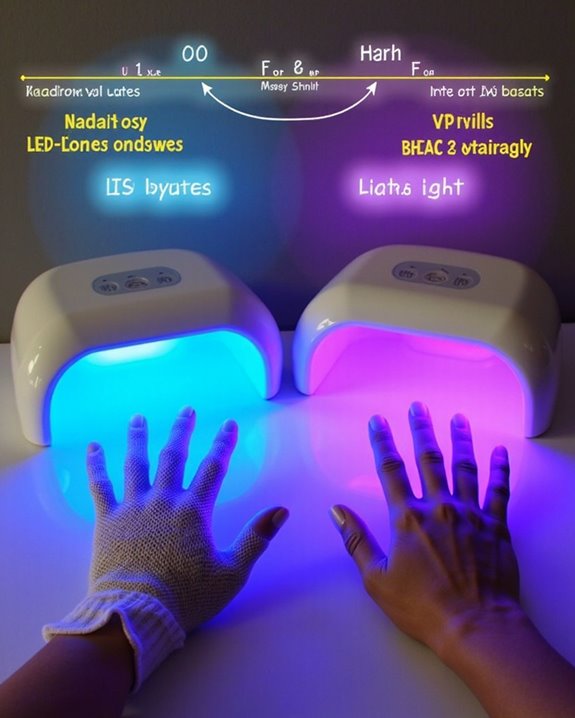
Scientific evidence regarding LED nail lamps demonstrates why they’re considered the safer alternative for gel nail treatments compared to traditional UV lamps. Unlike tanning beds which emit ultraviolet radiation at concerning levels, LED lamps produce considerably narrower wavelengths specifically targeting the photo-initiators in UV gel formulations. I’ve reviewed studies where professors of dermatology have deemed safe these devices based on their substantially lower energy output—often producing a fraction of the radiation compared to conventional lamps used in the nail salon setting. Additionally, the wavelengths emitted by LED lamps are optimized to activate gel polishes efficiently while minimizing unnecessary exposure to harmful rays. Board-certified dermatologists confirm that the concentrated, efficient light from LED diodes allows for faster curing of gel nail polishes while minimizing unnecessary radiation exposure. This technical advancement represents a significant improvement in the beauty industry, reducing potential skin cancer risks while maintaining the effectiveness that professionals demand.
Frequently Asked Questions
Is a LED Nail Lamp Safer Than UV?
Yes, I’d say LED nail lamps are safer with lower UV exposure and reduced skin damage risks. They offer better user safety, less heat emission, and favorable health effects for long-term use. Still, eye protection is recommended.
Why Do My Nails Hurt Under a LED Lamp?
Your nail pain under LED lamps is likely due to heat sensitivity during rapid curing. I’ve found application errors or cure discomfort can trigger LED irritation. Try pain prevention methods like hand cloths to minimize skin reactions.
Which Is Better, UV LED or UV C LED?
I’d recommend UV/LED over UV-C LED for nails. The wavelength differences matter – UV/LED offers better efficiency, versatility, and safety. UV-C’s technological innovation is great for sanitizing, but excessive for nail application and consumes more energy.
What Is the Difference Between LED and UV Lights in Milady?
Did you know LED bulbs last 12 times longer than UV lights? In Milady’s context, I’ve found wavelength differences, efficiency contrast, and cure speed are key distinctions. LED’s focused spectrum varies markedly from UV’s broader emission types.


